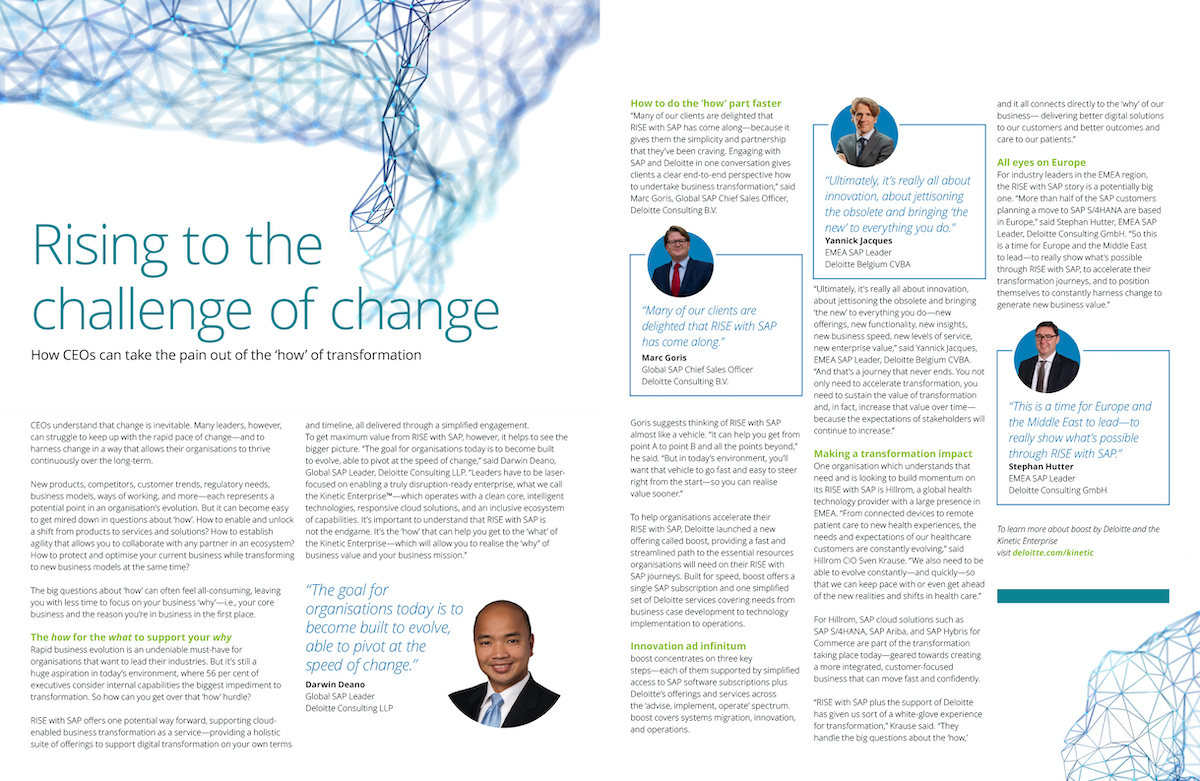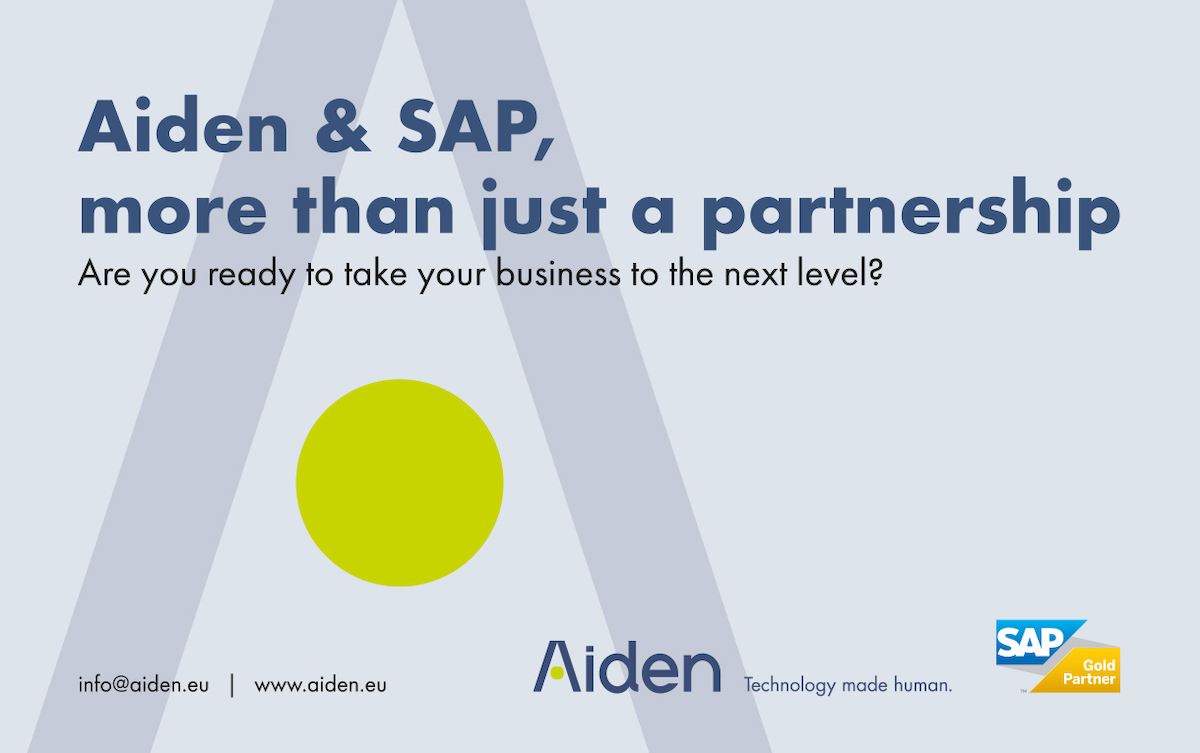Nearly everyone who shops online will have experienced SAP technology. If you’ve logged on to buy a T-shirt, band merchandise or pharmacy medication, then you’ll have benefited from the software, even if you’ve never heard of it. Globally, more than three-quarters of all transaction revenue goes through SAP systems, generating US$46 trillion (€38.7 trillion), or 87 per cent of total global commerce.

An incredible 94 per cent of the world’s 500 biggest companies are among SAP’s 22,700 partner companies in more than 140 countries. But we’re not just talking about giant multinationals – 80 per cent of users are small and medium-size enterprises. Such reach and scale are difficult to comprehend, yet it’s been so transformational for dozens of industries that the momentum shows no sign of slowing.
A good example of its domination comes from a frantic phone call SAP Netherlands received in spring last year from a government department. COVID-19 was in the process of locking down several European countries, and ministers were urgently devising contingency plans in case vital services became affected. They’d drawn up a list of 250 institutions from both the Netherlands and elsewhere that were considered critical to the nation’s infrastructure and wanted to know how many used SAP Netherlands’ software.
Among them were electricity and gas suppliers, water companies, hospitals, universities, public services, major groceries, ministries and many more. As travel and face-to-face meetings were now impossible, would SAP still be able to keep its systems going if there were major outages or system failures?
It turned out that 80 per cent were existing customers, demonstrating that SAP has become critical for the normal functioning of Dutch society. The company was able to make assurances that everything would indeed continue to run smoothly.
A Big Idea
So what exactly are these magical tools that are seemingly keeping the planet ticking over? Well, the company was formed a surprisingly long time ago, given the cutting-edge technology on which it relies.
In 1972, a small group of former IBM employees in Germany – Dietmar Hopp, Hasso Plattner, Claus Wellenreuther, Klaus Tschira and Hans-Werner Hector – had a big idea. It was a vision for a computer program that could bring together all the various departments of a big company so each could see the big picture.
Until then, there was no way of centralising data from different divisions, customers and suppliers. Within a year, the company had its first commercial product and orders started stacking up.
Many competitors have emerged since then, but SAP (System Analysis and Program Development) has remained the market leader and continues to provide industry-leading enterprise resource planning software for all core activities such as procurement, manufacturing, audience management, sales, marketing, finance and human resources. By last year, it had 102,400 employees and a revenue of €27.3 billion.
Through its cloud-based ERP applications, as well as continuous hosting and support, SAP ultimately unburdens customers so they can focus on their business. As you might expect from a company devoted to making other companies run like clockwork, SAP itself has harmonised its services internationally.
So while its buildings around the world may be different, the experience of walking into an office in Paris, Mexico City, Sydney, Munich or Singapore will be very similar. Wherever they’re located, the life cycle management of a customer is guided by similar principles at each stage of the journey and flawlessly integrated. Global tenets about best practice are melded to fit with local considerations.
Even today, many firms still have no system that allows them to store and analyse data that’s been input from multiple sources. Marketing teams may be using outdated intelligence, a regional sales office might not be aware of new product analysis, and a financial audit could flounder if an intern has forgotten to convert a currency.
Using several retail databases runs the risk of the same buyer inhabiting each one and being sent duplicated communications. In short, more time ends up being spent on running the business than selling the actual products.
By centralising the management and processing of information, SAP software means one source is available to everyone that’s updated in real time, increasing productivity, reducing staffing costs and making the commercial offering more competitive.
Growing Business
SAP Netherlands is based south-east of Rotterdam in the historic city of ‘s-Hertogenbosch. The 700 staff serve 1,250 customers and work closely together with global systems and business integrators like Accenture, Aiden, Deloitte, PwC, EY, IBM, KPMG and Capgemini. In just five years, it has grown its cloud revenues tenfold.
In terms of its professional services engagement, part of the resources come from the Netherlands with the remainder from international resources. A Dutch customer who engages SAP will not only benefit from extensive local knowledge but also from a wealth of industry experts from around the globe.
For instance, if they’re planning an international rollout, SAP will have people on the ground in each territory to offer game-changing advice on local culture and infrastructure.
Or if the Dutch operation takes on a client in an industry it’s not familiar with, it can simply find out which national operation has someone who is. The talent pool is almost infinite. In return, many of the Netherlands teams look after major overseas businesses looking to gain a foothold in The Hague, Amsterdam or Utrecht.
As so many corporations have discovered in the past 12 months, when meeting in person is no longer an option, a lot can still be achieved via Zoom or Microsoft Teams, especially if the expert you need to consult lives on a different continent. Client feedback in the Netherlands was that many actually prefer remote meetings as they increase efficiencies.
When you have consultants and technicians travelling vast distances for work-in-progress meetings, valuable days are lost while they’re in transit. And when an issue arises over a weekend, consultants several time zones away can often simply log on from home and give immediate advice.
The Power of AI
SAP Netherlands is helping clients harness the power of artificial intelligence. Research company IDC predicts that global spending on AI will double in the next four years to an estimated US$110 billion (€92.6 billion) and argues it is becoming indispensable for the survival of companies. “Companies will adopt AI – not because they can, but because they must,” says Ritu Jyoti, Program Vice President, Artificial Intelligence at IDC.
Changing Mindsets
However, SAP isn’t just an off-the-peg purchase to make things a bit better; it involves substantial organisational change. Not only will it make digital processes operate in a radically different way, mindsets too must alter to comprehend the extraordinary functionality that becomes possible.
Importantly, as every single business is unique, there are no overarching, generic templates that neatly fit every client. Engineers design bespoke models and then work out the optimum way to execute them. But even though SAP is accountable for the smooth running of the operation, the customer still needs to take responsibility for making sure the entire organisation buys into the new ways and adapts accordingly.
What SAP has found is that, overwhelmingly, staff at every level feel empowered when they see the new operation in action and enjoy being more involved at a macro level. They have visibility over areas they previously knew little about and their own jobs are made easier with access to a wealth of accurate data.
Silver Lining
The story doesn’t stop there. The transition to cloud-based providers means updates happen seamlessly, without employees or customers even realising. When you use Google, you have no idea which version of its search function you’re using. The same with Zoom – it’s automatically the latest version. You don’t need an IT technician to open up your computer or shut down the server to install an add-on. In fact, updates can be applied worldwide in an instant.
In recent years, it became possible to host operations in the cloud. It meant closer, ongoing relationships where responsibility for the smooth running of processes fell to SAP. Whatever the problem, SAP was on the case instantly, seven days a week, to find a solution and apply it to the situation.
The shift to delivering a holistic service has led to what the company calls ‘customer intimacy’, having deep, meaningful relationships over many years. A dedicated representative will check in regularly to monitor the performance of key processes, conduct quarterly reviews and arrange one-on-one meetings with executives.
By getting to know the individuals in a company, it can dig deeper into their challenges and specific needs to help them run their business. If there are a dozen colleagues utilising a database, each might approach it with a different viewpoint, even though the fundamental principle is one of consistent data. Only by taking time to understand everyone’s opinion can progress be made.
SAP has renamed its customer-facing operation ‘customer success’ to embed the idea that no job is done until the client is completely satisfied. That’s the thing that really counts. Only then will it have earned the right to move on to the next project.
Indeed, taking a big-picture view has also been a huge cultural shift for the SAP sales staff. In the past, it was about selling software that they knew someone else was going to implement. Now, they’re responsible for the entire life cycle of the customer, which could be a relationship lasting years.
Transplanting A Company’s Heart
The switch to a cloud-based model was one of the biggest upheavals SAP has experienced, yielding extraordinary results. But transitioning ERP to the cloud was a far greater undertaking due to so much more customer customisation.
SAP likens the process to a heart transplant. When the surgeon takes out the old organ, they keep the patient alive by making sure blood is pumping around the body and oxygen is getting to the brain. They also have to cut all the arteries leading to the heart and then stitch it all back together with the new heart. The core principles are the same for ERP. Every part of the organisation is connected to it: logistics, finance, retail, data systems, customer interfaces, partner liaison and others.
In the past two decades, retailers will have built a platform on top of their systems for online shopping and linked it to personnel management and purchasing systems. Over the years, it will have been modified and enhanced as the business grew and became more complex. All kinds of elements have to be carefully decoupled before the old system can be taken out and a new one installed.
But just because it’s convoluted, doesn’t mean it’s not worth the hassle. The effect on a company, whatever its size, can be every bit as consequential as a new heart is for a human, so demand is high and will be one of the main drivers in SAP Netherlands’ growth in the next five years.
Another area for growth will be the move towards reducing harmful emissions and switching to clean energy. Today’s successful organisations aren’t driven solely by financial success. They’re increasingly aware of their impact on the world – social, environmental and economic.
Linear business models built around ‘take, make, waste’ are being superseded by circular ones characterised by ‘resources, recovery, re-use’. According to the Ellen MacArthur Foundation, of which SAP is a contributing member, such practices could reduce 45 per cent of carbon emissions and 90 per cent of materials currently discarded.
SAP is actively helping clients look at new revenue growth opportunities based on circularity at scale and has identified three ways to achieve it. The first is eliminating surpluses through a detailed examination of process efficiencies. The second is GreenToken by SAP, an initiative that gives invaluable insight into where original equipment manufacturers are sourcing raw materials.
Combining that with blockchain technology can provide a new level of transparency in the supply lines of minerals and components, particularly plastics, so sustainable procuring becomes an option.
The third factor is gaining an oversight of an entire network so a specific aim, like reducing single-use plastic, can be implemented, sometimes across a whole industry.
In July, SAP Netherlands announced a partnership with Siemens and T-Systems to accelerate sustainability in Dutch businesses by focusing on smart industry (Industry 4.0), energy transition and innovative technologies.
The collaboration aims to benefit customers through the optimised digitalisation that will come from the integrated approach of the three organisations. A climate-neutral, circular economy will increase efficiencies and earning capacities at the same time in the coming years.
However, it does depend on further investments in digital processes so that companies can compete more easily in international markets. Hopes are high that it will make a tangible impact on emissions and help major companies move more quickly to carbon neutrality.
If SAP Netherlands has proved one thing time and time again, it’s that no challenge is too great thanks to its customer-centric service and adaptable software. Its story thus far is unrivalled in terms of success, but the company has the feel and culture of a passionate and dynamic startup that’s just getting into its stride.
RISE WITH SAP
RISE with SAP is a new initiative to simplify and expedite business transformations without a substantial up-front investment. Companies can use their own time lines and choose services that will turn them into smart enterprises with cloud-based, integrated operations. The service is already proving popular as it removes complexity from the process for both employees and clients, even offering courses to teach a customer’s employees the skills they’ll need when the new set-up is ready to go live. “RISE with SAP provides simplification, for our customers and our company,” says Capgemini Executive Vice President Brad Little. “Combined with Capgemini’s capabilities, this leverages the added value of SAP to support our customers’ business transformations.”.
Proudly supported by:




